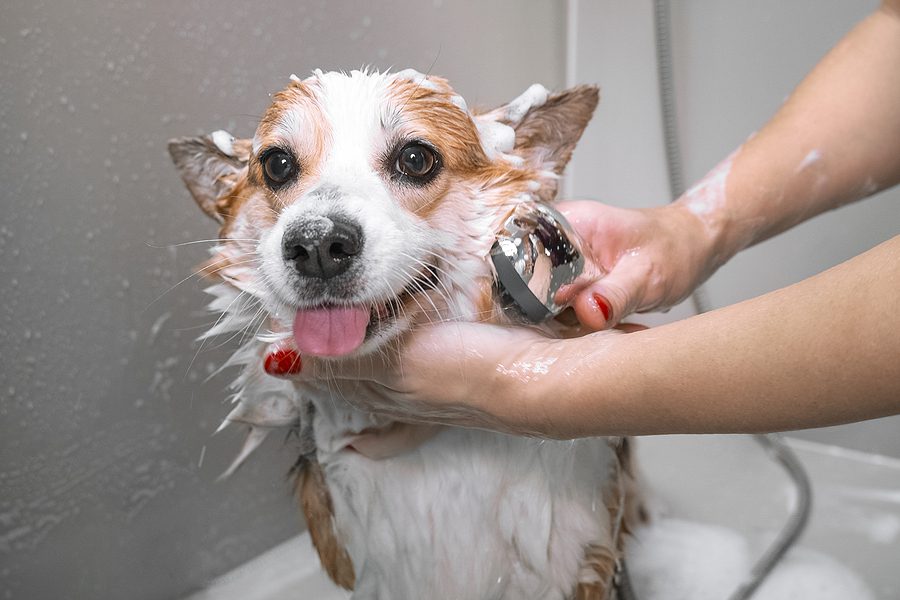Some dogs love a good bath, while others want nothing to do with it. But baths are an important part of regular dog care, even if they resist this hygienic practice.
How often should you bathe your dog, exactly? Can you give puppy a bath? It can depend on your dog and its circumstances. No prescribed bathing schedule suits all dogs, and when determining bathing frequency, several factors must be considered. Here’s what you need to consider when planning your bathing routine for your dog.

How often should you bathe your dog?
A general rule for bathing dogs is that the longer their coat of hair is, the more frequently they’ll need to bathe. While a dog with a medium-to-long coat of hair may require baths as often as every four to six weeks, many short-haired breeds can go well over a month before a bath.
There can be some exceptions, though. Certain short-haired breeds of dogs have very sensitive coats and skin that require as many as weekly baths. And some long-hair breeds may not require a monthly bath if their activity level is low.
The activity level may play a significant role in determining how often to bathe a dog. In the summer or during high activity, dogs may produce more oils through their skin and develop an odor faster. Many owners may give more regular baths during warmer months and go longer between baths during the fall and winter.
You can also over-bathe your dog; excessive bathing and harsh soaps can dry your dog’s skin and lead to itching. If you’re uncertain about your dog’s bathing needs, consult your veterinarian for expert advice.
How often do dogs need a bath?
Here are some breed-specific answers for how often should you bathe your dog:
- How often should you bathe a Labrador? In most cases, the short coats on Labradors only require bathing on at most a monthly basis or as little as once every three months. Too much bathing can strip away important natural oils in their coat and on their skin, irritating them.
- How often should you bathe a golden retriever? Golden retrievers have a much thicker coat than Labradors, so it’s no surprise that they need more frequent baths. Experts recommend a bath at least every six weeks for this family pup.
- How often should you bathe a shih tzu? A Shih Tzu’s thick, curled coat requires more attention than many other breeds. A shih tzu should typically be bathed every three weeks to keep its skin and hair healthy to prevent bad smells from developing.
- What about bathing poodles? Much like a shih tzu, the coat on a poodle is best served by a bath every three weeks.
- How often should a bichon frise get bathed and groomed? This breed has famously high-maintenance hair and may require a bath every two weeks. In addition, the hair also needs to be trimmed to prevent matting and other issues.
- How often should a dog be groomed? Any tips on grooming dachshunds? Both long-haired and short-haired dachshunds only require a bath every three months, assuming they aren’t getting into messes. With long-haired dachshunds, brushing their coat is recommended to keep them in good health.
How can you improve your dog’s comfort while taking a bath?
Bathing your dog can be an emotionally draining experience. Here are a few pointers to make the process less stressful for your dog—and perhaps even turn it into an event they look forward to:
- Gather your supplies before the bath begins. Minimizing your dog’s time in the bath can reduce the stress of this necessary task.
- Check your bathwater temperature before placing your dog in the water. Hot water can cause pain and even skin damage in your pet, whereas cold water is unpleasant and can aggravate stress. Lukewarm to mildly warm water will keep your dog safe and comfortable.
- Use dog shampoo or baby shampoo. These shampoos will contain gentler cleaning agents, preventing your dog from being irritated by the soap or developing a stinging sensation when using them.
- Bathe your dog in the same tub when possible. This consistency will improve your dog’s comfort, whether it’s a tub, a basin, or another location.
Some dogs will never enjoy bathing, no matter how many precautions you take to make them more comfortable. However, these modifications can make regular baths more bearable for your dog and easier for you to handle on your own.
What are some practices for bathing your dog due to fleas and other problems?
Fleas, mud, irritated skin and other complications can prompt an immediate bath, even if it’s earlier than your dog’s regular schedule. Getting your dog into the bath quickly is important to save them from additional discomfort associated with their condition. Here are some pointers to help you face these challenges:
- Use a flea-killing shampoo or conditioner. This is beneficial if they have come into contact with an irritant or developed dry or itchy skin due to allergies or environmental factors.
- If your dog is muddy, consider washing them outside. Too much mud could clog your indoor plumbing, creating an even bigger—and more expensive—mess.
- Use a detachable showerhead to provide a deeper clean. These showerheads can help clear the salt and other debris in your dog’s paws, and thoroughly clean their underside.
Bathing your dog isn’t always easy, but keeping their coats and skin healthy is important. Keep up on these caretaking tasks to avoid additional problems affecting your dog’s quality of life.
Recent Posts
About Us
At Forever Vets Animal Hospitals, we provide full-service veterinary care across multiple Florida locations, offering a wide range of preventive, diagnostic, surgical, and emergency services for pets. Our team focuses on exceptional care, affordable wellness plans, and creating a welcoming environment for both pets and their owners.
